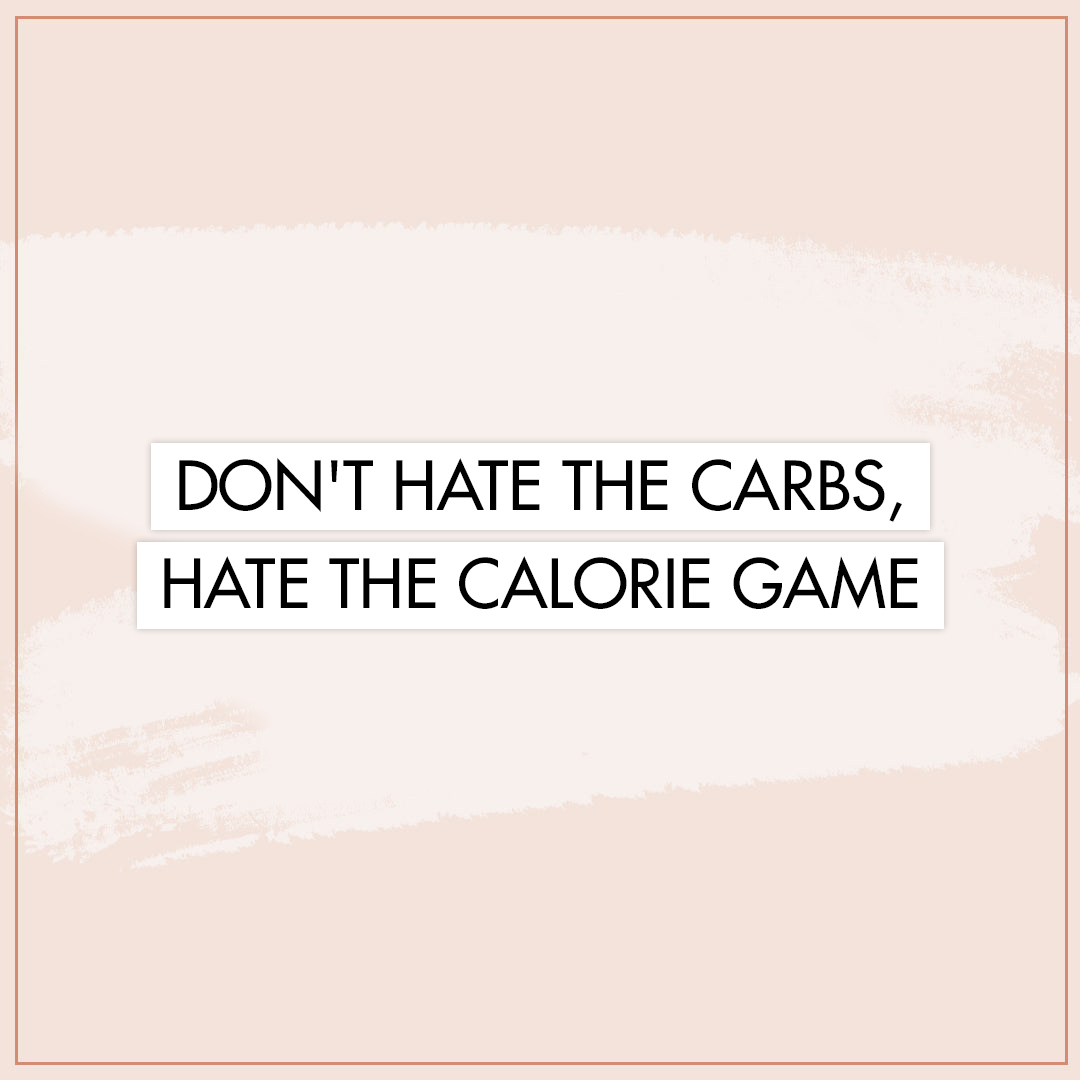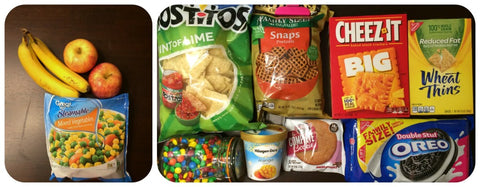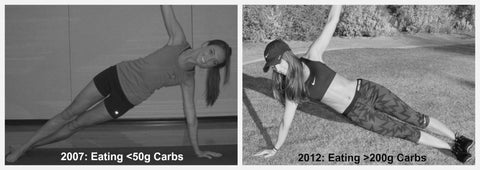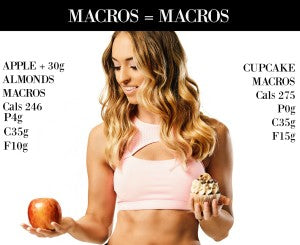Don’t Hate the Carbs, Hate the Calorie Game

Today’s guest post comes courtesy of Stephanie Dorworth of BeautifultotheCore.com. She and her husband Zach are launching a free four-week e-course on flexible dieting that you may want to check out – details at the end!
There was once a 20-year old college student who was afraid of gaining weight again. She had gained the freshman fifteen and worked really hard to lose it. She was not going to re-live that, no matter what. So she did what she thought was best: she restricted her carbohydrate intake, which resulted in consuming fewer calories. In her mind, carbs were evil, necessarily led to weight gain, and resulted in her unhappiness.
Her diet was limited to mostly fruits, veggies, meat, and salads, and she never took a day off of exercise. As a result of her efforts, she was able to maintain bodyweight. Success!
She felt awful, though. She was tired, sore, unhappy, hungry, and weak. Her body was not functioning optimally.
Several years later, she realized she needed to make a positive change because she felt exhausted all the time. She transformed her life by reverse dieting and slowly eating more carbs. Her carbohydrate intake gradually increased to over 200 grams per day and became her main energy source again. Because of this, she was no longer tired, she was in a better mood, she felt happier, and she was stronger in the gym. She started ovulating again and having regular bowel movements.
Take a look at the carbs she used to eat versus the carbs she eats now and then answer that question.

Then: Wheat Thins, fruits, and veggies.
Now: Rice cakes, rice, cookies, sweet potato, oatmeal, beans, pop tarts, pretzels, granola, bread, Cheez-Its, donuts, chips, and pasta.
You may assume this person doubled in size, body fat, and weight. This is not what happened.
Let me be honest: that woman was me in my college years. And no, I did not blow up. Just the opposite, in fact. I got healthier, stronger, and happier. I can yell it from the mountain tops now that I love carbs!

As it turns out, my body needed more carbs – desperately.
Why do people assume that carbs cause an increase in weight or body fat? Possibly due to the negative stigma carbs have gotten for years. Possibly due to the foods associated with carbs like bread and pasta.
All these fad diets have brainwashed us into thinking low carb diets are required to lose weight. That is a myth.
Do they work for some people? They can work, yes, because restricting a food group is an easy way to also restrict calories. However, this method is by no means required and, for most people, is not sustainable.
Breaking the “Carbs are Bad” Myth
Carbohydrates can either be simple or complex. Simple carbs are made up of just one or two sugar molecules and they include foods like syrups, jams, juice, and candy. Complex carbs are made up of a coil of sugar molecules that are often rich in fiber, micronutrients, and vitamins.
Carbohydrates are important for your brain function, muscle function, intestinal function, and lastly providing you with energy for your workouts. If you’re someone who works out regularly, you can understand how a low-carb diet could hinder your ability to fuel through a workout and recover from training sessions properly.
Here are some signs you may be eating too little carbs:
- Bowel/digestive problems (due to lack of fiber)
- Micronutrient deficiency
- Lethargy
- Decreased physical performance
- Poor muscle recovery after workouts
- Mental fatigue
- Difficulty building muscle

The negative stigma surrounding carbohydrates goes back to the infamous Atkin’s diet when people were taught that they had to cut carbs to lose weight.
Here’s what actually happens: during the first few days of making a drastic change to a low carb diet, water weight is lost as the body’s glycogen stores are depleted – not body fat. And when people eliminate carbs, they cut out all the garbage they were eating in the first place. This in turn leads to a decreased calorie intake.
This is a classic case of correlation being confused with causation.
You may then think that you’re getting more fit, but as soon as you go back to eating more carbs again, you will gain that water weight right back.
Carbs are not bad; for most people, they’re a necessity.
Don’t Hate the Carbs, Hate the Calorie Game
Weight gain is based upon the energy balance relationship of energy in versus energy out. In the most basic sense, if the number of calories consumed is higher than the number of calories expended, you will gain weight.
Proteins, carbs, and fats make up the three macronutrients in your diet. One gram of protein has four calories, one gram of carbohydrates has four calories, and one gram of fats has nine calories. A little bit of arithmetic will yield your total calorie intake for each day.
As long as you have a solid balance of macros that equate to a number of calories equal to how many calories you expend, you’ll maintain your bodyweight. Ingest too much and you’ll put on weight; eat in a deficit and you’ll lose weight.
It’s not the carbs themselves that induce weight gain, then, but an excess of calories. If you consume an excess of protein which then tips you over your energy balance for the day (unlikely, but possible), then you can absolutely gain weight from that. The same goes for fats.

Reverse Carb’ing
You should be getting 30-65% of your total daily energy from carbohydrates. For example, if you eat 2000 calories a day, your carbohydrate intake should be between 150g-325g. Stick to the lower end of the range if you are trying to lose fat, working out less frequently or intensely, or are sensitive to carbohydrates. Consume in the higher end of the range if you are reverse dieting, working out frequently and intensely, or if you simply feel better on a higher carb diet. When in doubt, eat in the higher end of the range.
If your carb allotment is higher, you increase the likelihood you will adhere to your diet since you have more freedom with what you eat. That is crucial to fat loss success.
Does that sound like a lot?
I encourage you to consider eating more carbs. Not only will you feel better, stronger, and happier, but you will also be able to get leaner. For me personally, the largest hurdle to get over was my fear of carbs. Anytime I ate more than fruits or veggies as carb sources, I felt guilty. Eating ice cream, pasta, or bread felt foreign to me. In order to jump that hurdle, I reintroduced it back into my diet slowly with reverse dieting and macronutrient redistribution.
If you think you are eating too little carbs and want to work on slowly increasing your carbohydrate intake, then use reverse dieting like I did. For reverse dieting, you would increase your carbohydrate intake by anywhere between 5-10% every one or two weeks. Continue doing this as long as you are maintaining weight. If you start to gain weight, then hold that number steady until you are able to maintain again or decrease fat values a little if using redistribution. It’s slow process, but well worth the patience. See if you can join the 200g club!
(See Related: Reverse Dieting)
No Carbs Off Limits
When choosing which carbs to eat to meet your macro allotment, keep the rules of flexible dieting in mind. Flexible dieting consists of an 80/20 approach. This means 80% of your daily food intake should come from nutritious, wholesome, and minimally processed foods, while 20% can come from other foods you enjoy.
Here are some examples of wholesome carbs:
- Vegetables
- Fruit
- Bread
- Brown Rice
- Beans
- Oatmeal
- Sweet Potatoes
And examples of carb treats:
- Cereal
- Chips
- Donuts
- Granola Bars
- Oreos / cookies
- Poptarts
- Pretzels
- Ice cream
- Chocolate
- Pizza
- Burger
Enroll in Flexible Dieting University

My husband Zach and I just launched our brand new four week online course called Flexible Dieting University.
This course will teach you everything you need to know about getting started with Flexible dieting. Here’s what the course covers:
- Basics of flexible dieting
- Intro to macronutrients
- How to read nutrition labels
- How to use a kitchen food scale
- How to use the MyMacros+ app
- How to eyeball portion sizes
- How to track when eating out
- How to find your maintenance calories
- How to adjust macros for your goals
In addition, you get membership to a Facebook support group where you can communicate with other course students and receive support.
Sign up by July 6th, 2016 at midnight to join this four-week course! Did I mention that it’s free?
Flexible dieting gives you the freedom of mixing in the foods you crave will ensure long-term nutrition adherence and accomplishment of your goals. If you get 80% of your energy from wholesome complex carbs, that will help you get the recommended daily fiber intake. Make carbs your BFF this summer and your body will thank you.
In summary:
1. Carbs are good for you and your body needs them to function properly.
2. There are two types of carbs: simple and complex.
3. Carbs improve the function of your brain, muscles, intestines, and provide you with energy.
4. If you experience any of the signs of eating too little carbs, practice reverse dieting to increase your carb intake.
5. Remember, you can enjoy what you eat and not feel guilty about eating carbs because carbs are good for you.




